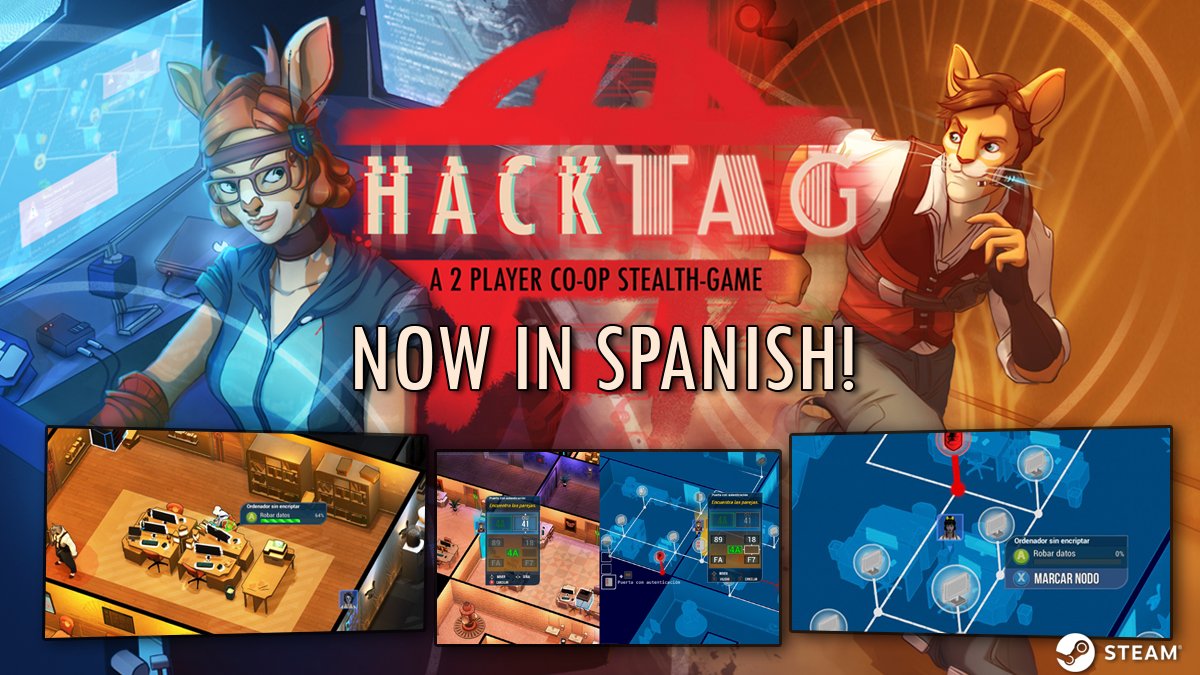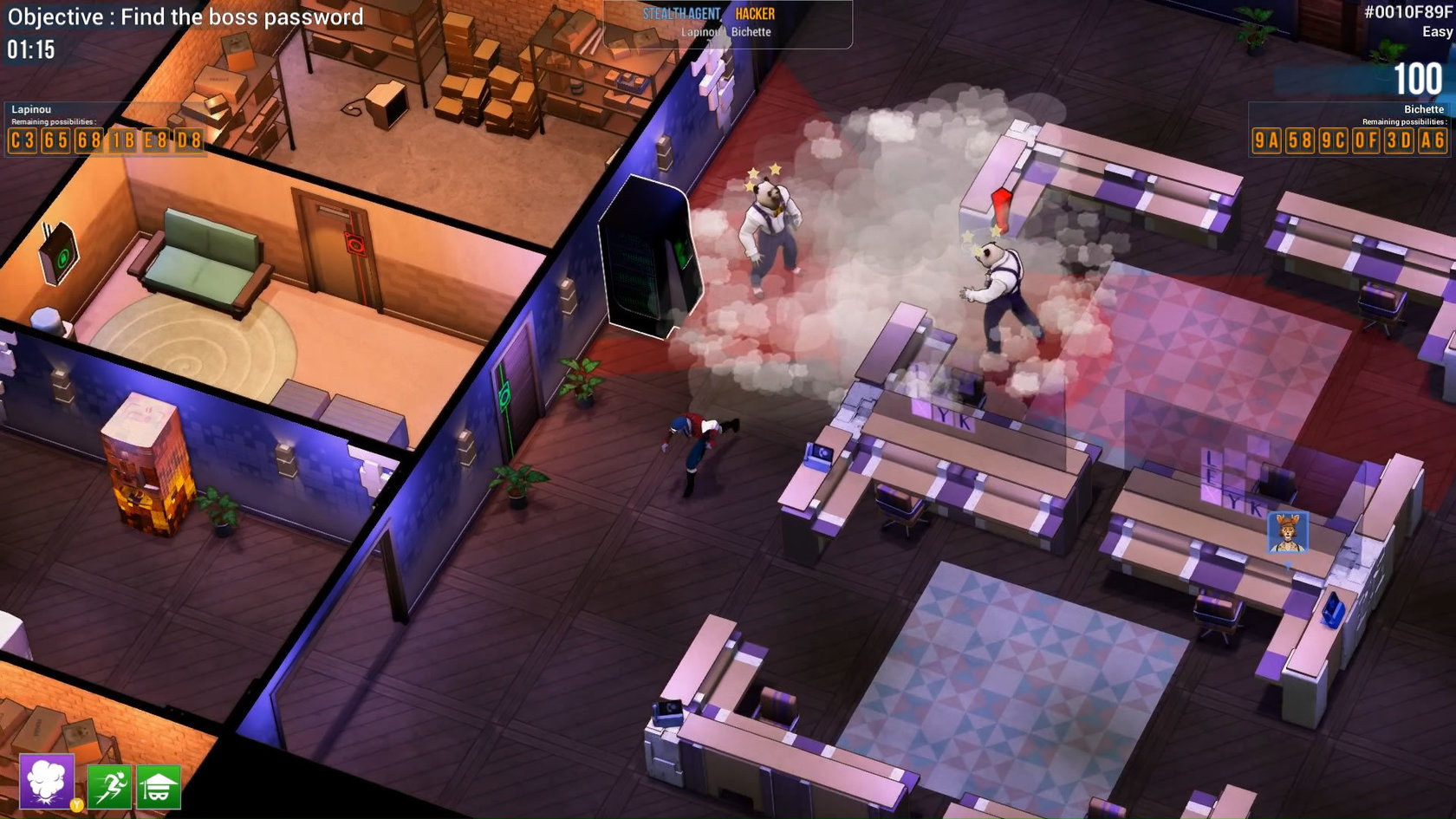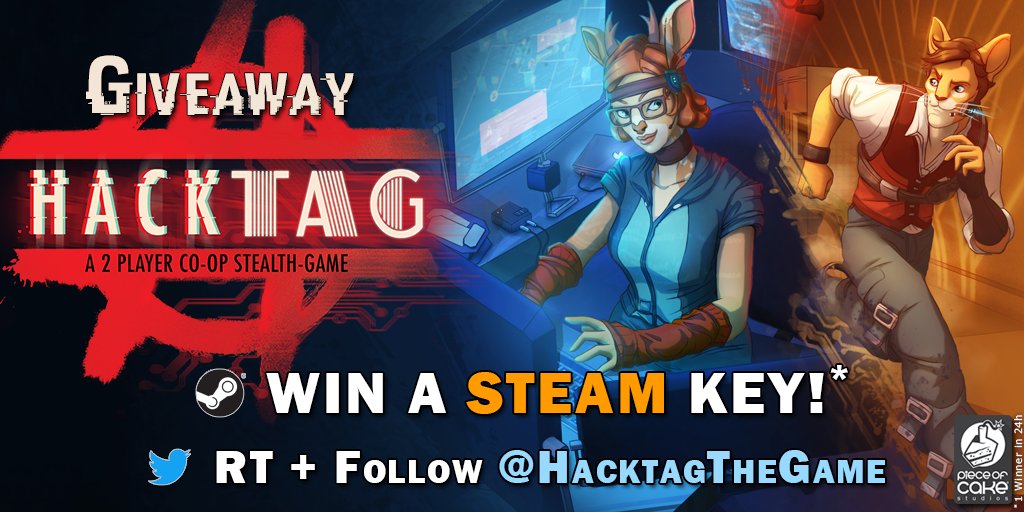Hacktag is a 2-player co-op stealth-game with an asymmetric gameplay. Play as the stealth Agent in the field or as the Hacker, virtually infiltrating and cooperating to fulfill industrial espionage. Your Score 0 Summary: Hacktag is a fast-paced two-player co-op stealth-game with unique asymmetric gameplay. Play as the stealth Agent in the field or as the virtually-infiltrated Hacker and work together to carry out espionage missions where nothing goes as expected. Hacktag Hacktag is a fast-paced 2-player co-op stealth-game with an asymmetric gameplay. Play as the stealth-agent on the field or as the virtually-infiltrated Hacker and work together to carry out espionage missions where nothing goes as expected!

- Hacktag is a 2-player co-op stealth-game with an asymmetric gameplay. Play as the stealth Agent in the field or as the Hacker, virtually infiltrating and cooperating to fulfill industrial espionage.
- Hacktag is a 2-player co-op stealth-game with an asymmetric gameplay. Play as the stealth-agent on the field or as the Hacker, virtually infiltrated and cooperate to fulfil industrial espionage missions together to takedown corporations.
SIMPLE BUT EFFECTIVE
In November of 2015, I played a game called Clandestine – a third-person, asymmetrical stealth infiltration game where one player assumes the role of an armed spy and the other plays the hacker helping her out. The game was plagued with poor balancing and a myriad of bugs, but the concept was brilliant. The game was later polished through patches and actually stands up pretty well today. Why am I writing about
Hackathon Ideas
Clandestine in a review of Hacktag? Because Hacktag is basically a cute, top-down casual version of Clandestine, and yes – it’s actually a pretty good game.When you first boot the game up, you’ll have to create a character. The humanoid animals on file range from cute to adorable, and come in both male and female versions. Outfits and accessories are also available and more are unlocked as you level your character up. In addition to that, when you start a mission, you’ll be able to assign special abilities to three slots. More abilities are also unlocked as you progress in the game, so customising your character and the experience you’ll have will lead to some variety in gameplay.
While one player plays the Agent and another plays the Hacker, only one is physically present in the level. To begin with, the Agent will have to open up a firewall console to give the Hacker access to the first part of the network. Some roadblocks can only be opened by either player, but most require either the Hacker or the Agent to deal with them. The rare checkpoint door, however, will require both to be present to unlock them. Hacking takes the form of directional QTEs a-la dancing games, but rather than following a rhythm, you simply have to punch in the full sequence of directions before the timer runs out. Simple, but effective.
COOPERATING SKILLS
Cameras can only be dealt with by the Hacker, and network scanners can only be disabled by the Agent. Antivirus sniffers jump between nodes scanning for the Hacker and security guards roam the halls on the lookout for the Agent. Gameplay therefore revolves around removing roadblocks from your partner’s path and distracting security measures so your partner can get past them. Making a phone ring to distract the guards and calling the antivirus to a particular server are examples. Each level has multiple computer terminals you’ll need to steal data from and a “Boss Computer” in which the most sensitive piece of info, and your goal, resides. Any other piece of data you can steal earns you points which level up your character and unlock more customisation for abilities and accessories.
That being said, the game’s lack of variety in puzzle and level design may harm its longevity. We found that after a two hour session with one partner, the game became fairly easy to read and as the Hacker and Agent became more synchronized, the puzzles failed to provide a challenge for experienced players. Switching out partners for less experienced ones, however, proved to be very fun as the game is perfect to teach younger players (kids) or inexperienced adults how to play. If the Hacker or Agent get caught, they’ll be taken into temporary holding from which the other player can release them within a short time frame. If time runs out, however, they’ll still get out but you’ll lose points that way. There is no violence in the game and the consequences of failure are not severe, so I’d argue this game is perfect for young kids and an excellent way to develop cooperating skills between players.
Hackathons Near Me

EASY-TO-LEARN SPY GAME

The game can be played online with a partner or couch co-op mode. There’s also a single player mode, but this is virtually unplayable. As communication is key, we found that couch co-op is the best way to go. Online multiplayer was also fun, but finding a partner who communicates clearly and effectively, and doesn’t veer off and start doing their own thing can be an issue if dealing with two Alphas. In the single player mode, however, the player will have to control both Hacker and Agent, which can often lead to the one you’re not paying attention to getting arrested while you’re navigating a particularly tricky puzzle. The game is clearly optimized for co-op, and that is where it shines. I would have appreciated the option to have one of the characters controlled by an AI in single-player mode – even if it was a “perfect player” whose actions were pre-scripted for each level like the one they already put into the tutorial.
If you’re looking for a fun co-op game for your kids or looking to get someone you know into gaming through a non-violent, cute, easy-to-learn spy game, Hacktag is definitely a good choice. Don’t expect it to hold the interest of experienced players looking for a challenge though. If you’re a grammarian who can’t overlook terrible typos and Google Translated text, and have a problem with the morality of corporate espionage however, you might cringe quite a lot when booting this game up. The aforementioned players who will like this game, though, surely won’t care about that sort of thing. Simply put, a hashtag is an easy way for people to categorize, find and join conversations on a particular topic.The hashtag is used to highlight keywords or topics within a Tweet, and can be placed anywhere within a post.Thanks to the member-driven online information site Twitter, the lowly 'pound' or 'number' symbol '#' has been elevated to a new role. The hash mark, or pound symbol, (#) is now known by social media users as a 'hashtag' or 'hash tag'. Posts that have the same keywords prefixed with the # symbol are grouped together in user searches, bringing a level of order to the frenzied chaotic world of Twitter.Twitter user Chris Messina (@chrismessina) first Tweeted with a hashtag symbol # in August 2007, as a way to define groups on the social media site. The use of the pound symbol to categorize messages and define conversations spread quickly throughout the Twitter community, and is now an integral part of this fast-paced live information network.According to Twitter, in 2011 over 10 percent of all Tweets now contain one or more hashtags. With an average of 140 million Tweets and half a million new accounts created every day, it is easy to see why users need some way of sorting through all these messages.
How Search Twitter Using Hashtags
Any Tweet posted on a public account can be searched by anyone, and posters often use hashtags to help direct searches to their posts. For example, Twitter users can elect to follow all Tweets that include the hashtag #WhiteSox to receive updates about the Chicago White Sox baseball team. Users looking for the best fuel prices can search for #cheapgas and the #osama hashtag was especially popular in May 2011.Posters can include more than one hashtag within a single Tweet, so when searching for posts users can enter multiple hashtag terms, like #NewYork#Pizza.Creating A Hashtag
Hacktag
Twitter users are free to develop and use their own hashtags as long as they fall within the Twitter rules set out by the company. These rules address issues like offensive and threatening language, as well as impersonating an individual, group or business.Before deciding on a hashtag, users should do some research to see what keywords are available. It's also important to keep hashtags brief, as the words and numbers prefixed with the # symbol are included in the 140-character limit per Tweet.Hashtags should be directly related to the topic. For example, users who want to set up a group for their running group might want to use a hashtag label that includes terms that group members would recognize, like #SFBayRoadrunners.When properly used, Twitter hashtags can be a powerful social media tool for business promotion and trend tracking.Hashtag Rules and Etiquette
Hacktag Gossip Girl
According to The Twitter Rules, Twitter accounts will be deemed to be 'spamming' if used to post numerous updates using a # that are unrelated to the hashtag topic or group, resulting in permanent suspension of the offending account.Because hashtags are relatively new, and the Twitter community at large generally dictates what is the norm on the site the acceptable use of hashtags is constantly evolving. The question 'what is a hashtag' is an ongoing one among social media users, and the definition of a hashtag continues to evolve.Currently, it is acceptable to tag only significant posts that will contribute to the general conversation with one hashtag. Using two hashtags is acceptable, especially when one of the # tags includes an actual location, such as #SanDiego and #wildfires. According to Wikihow, using three hashtags in one Tweet is the absolute maximum, and doing so risks 'raising the ire of the community.'